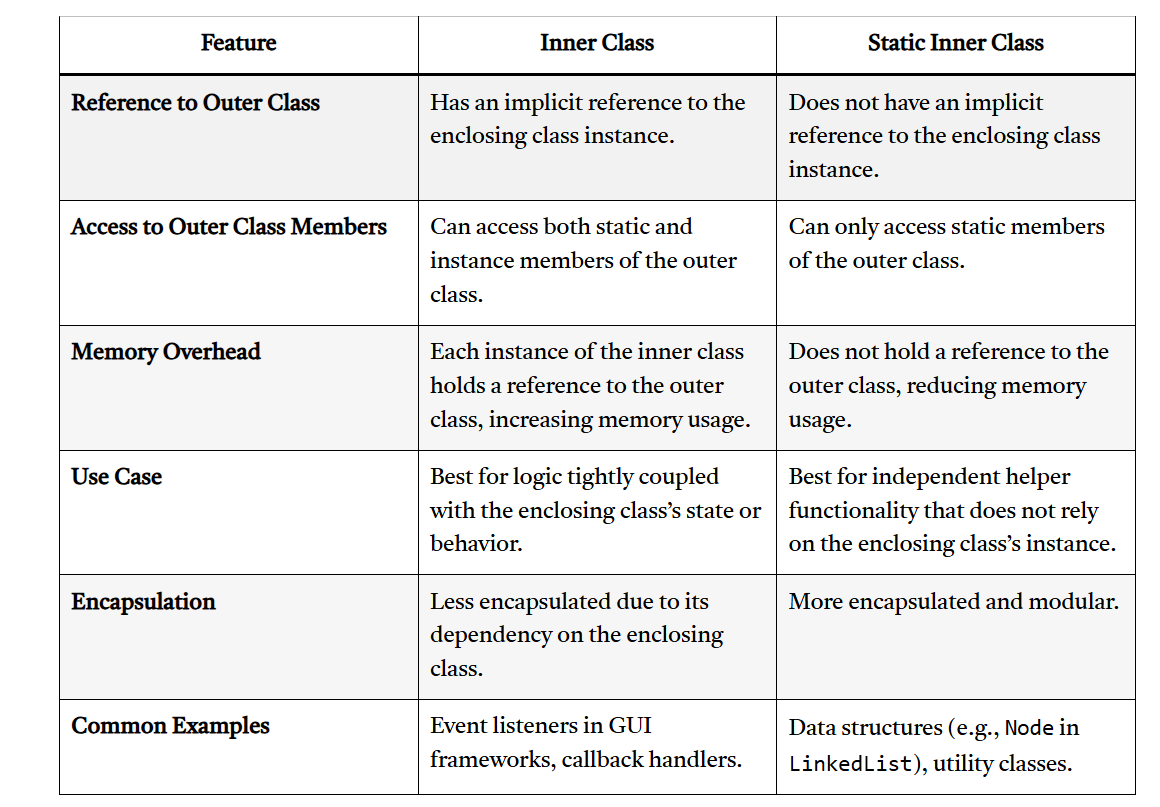Introduction
If you’ve ever worked with Java, you might have come across the term nested class in Java. But what does it really mean? At its core, a nested class is simply a class defined within another class. Think of it as a “class within a class,” where the inner class logically belongs to the outer class. It helps in keeping code organized, reducing clutter, and improving encapsulation.
Nested classes are not just a fancy feature they are a practical tool used by developers to structure complex applications more efficiently. In this article, we’ll explore everything about nested classes, their types, examples, best practices, and even some real-world use cases. By the end, you’ll feel confident in using nested classes in your own Java projects
What is a Nested Class in Java?
A nested class in Java is simply a class that resides inside another class. Unlike a regular class that exists on its own, nested classes are tied to the outer class. They are useful when you want to logically group classes that are closely related.
For example, imagine creating a Car class and a Engine class. Instead of keeping them separate, you can define Engine as a nested class inside Car. This clearly communicates that an engine belongs to a car, improving readability and structure. Nested classes can also access private members of the outer class, which is a handy feature for encapsulation and tighter integration between classes.
Why Use Nested Classes in Java?
Using a nested class in Java isn’t just about organization it has several practical advantages:
- Better Encapsulation – Nested classes can access private members of the outer class. This helps keep sensitive data hidden from the rest of the program.
- Logical Grouping – When a class is useful only in one place, nesting it avoids cluttering the global namespace.
- Improved Readability – Code is easier to understand when related classes are grouped together.
- Cleaner Code – Reduces the number of top-level classes in your project, keeping it manageable.
For beginners, it might seem a bit complex, but once you understand the types and use cases, nested classes become a natural part of Java programming.
Types of Nested Classes in Java
In Java, nested classes are divided into two main categories: static nested classes and inner classes. Each has its own purpose and behavior.
- Static Nested Class: Declared with the
statickeyword. It cannot access non-static members of the outer class directly. Think of it as a separate entity tied to the outer class. - Inner Class: Non-static nested class that can access all members of the outer class, including private ones. Inner classes are further classified into:
- Member Inner Class – Defined at the member level of the outer class.
- Local Inner Class – Defined inside a method of the outer class.
- Anonymous Inner Class – Defined without a name, often used for quick implementations.
- Nested Interface – A special case where an interface is defined within a class.
Understanding these types is key to effectively using nested classes in Java.
Static Nested Class Explained
A static nested class behaves like a static member of the outer class. You don’t need an instance of the outer class to create it. This makes it efficient when you want to group classes logically without creating unnecessary dependencies.
Example:
class Car {
static class Engine {
void start() {
System.out.println("Engine started");
}
}
}
public class Main {
public static void main(String[] args) {
Car.Engine engine = new Car.Engine();
engine.start();
}
}
In this example, Engine is a static nested class. Notice how we didn’t need a Car object to create Engine. Static nested classes are ideal for utility or helper classes that don’t rely on the outer class instance.
Member Inner Class Explained
A member inner class is a non-static nested class defined at the member level. Unlike static classes, it requires an instance of the outer class to be instantiated.
Example:
class Car {
private String brand = "Tesla";
class Engine {
void displayBrand() {
System.out.println("Car brand is " + brand);
}
}
}
public class Main {
public static void main(String[] args) {
Car car = new Car();
Car.Engine engine = car.new Engine();
engine.displayBrand();
}
}
Here, the inner class Engine can access the private member brand of the outer class Car. This demonstrates the power of inner classes—they can tightly integrate with their outer class.
Local Inner Class Explained
A local inner class is defined inside a method of the outer class. These classes can access final or effectively final variables of the method.
Example:
class Car {
void startEngine() {
class Engine {
void start() {
System.out.println("Local engine started");
}
}
Engine engine = new Engine();
engine.start();
}
}
public class Main {
public static void main(String[] args) {
Car car = new Car();
car.startEngine();
}
}
Local inner classes are useful when a class is needed only inside a specific method, keeping the outer class clean and readable.
Anonymous Inner Class Explained
An anonymous inner class is a nested class without a name. It is often used to implement interfaces or extend classes quickly.
Example:
interface Engine {
void start();
}
public class Main {
public static void main(String[] args) {
Engine engine = new Engine() {
public void start() {
System.out.println("Anonymous engine started");
}
};
engine.start();
}
}
Anonymous inner classes are commonly used for event handling in GUI applications or when a short-lived class is needed without formal declaration.
Nested Interface in Java
Java also allows interfaces to be nested inside classes. This is useful for defining contracts related only to the outer class.
Example:
class Car {
interface Engine {
void start();
}
}
class Tesla implements Car.Engine {
public void start() {
System.out.println("Tesla engine started");
}
}
public class Main {
public static void main(String[] args) {
Car.Engine engine = new Tesla();
engine.start();
}
}
Nested interfaces provide clear boundaries and logical grouping for related functionality.
Best Practices for Using Nested Classes
While nested classes are powerful, using them wisely is crucial. Here are some best practices:
- Keep It Relevant – Only nest classes that are logically tied to the outer class.
- Avoid Over-Nesting – Too many nested levels can make code confusing.
- Use Static When Possible – If the inner class doesn’t need access to the outer class instance, make it static.
- Encapsulation First – Use private access modifiers to keep inner classes hidden when needed.
- Readable Names – Choose meaningful names for inner classes to improve code clarity.
Following these rules ensures your code stays maintainable and easy to understand.
Real-World Use Cases
Nested classes appear in many real-world Java applications:
- GUI Programming: Anonymous inner classes handle button clicks or events in Swing and JavaFX.
- Data Structures: Inner classes define nodes in linked lists or trees.
- Utilities: Static nested classes act as helper classes for operations like sorting or parsing.
- Encapsulation: Grouping small utility classes inside a main class for better organization.
These use cases show that nested classes are not just theoretical they have practical, everyday applications.
Common Mistakes to Avoid
Even experienced developers sometimes misuse nested classes. Common mistakes include:
- Overusing Inner Classes – Nesting everything can make code hard to read.
- Ignoring Access Modifiers – Failing to encapsulate inner classes properly exposes sensitive data.
- Unnecessary Static Classes – Making classes static when they need outer class access causes errors.
- Confusing Anonymous and Local Classes – Remember that anonymous classes have no name, while local inner classes do.
Awareness of these mistakes ensures you use nested classes effectively.
FAQs About Nested Class in Java
1. What is the difference between a static nested class and an inner class?
A static nested class doesn’t require an instance of the outer class, while an inner class does.
2. Can a nested class access private members of the outer class?
Yes, non-static inner classes can access all members, including private ones.
3. When should I use an anonymous inner class?
Use it for short-term tasks, like event handling or quick interface implementations.
4. Are nested classes memory-efficient?
Yes, especially static nested classes, as they don’t carry a reference to the outer class instance.
5. Can interfaces be nested in Java?
Yes, interfaces can be declared inside classes to logically group related contracts.
6. Are nested classes considered best practice in Java?
Yes, when used judiciously for encapsulation and logical grouping of related classes.
Conclusio
Nested class in Java are more than a syntactic feature they are a tool for cleaner, more organized, and more efficient code. From static nested classes to anonymous inner classes, each type has a clear purpose and practical use case. By understanding their behavior and best practices, you can write Java programs that are easier to read, maintain, and scale









